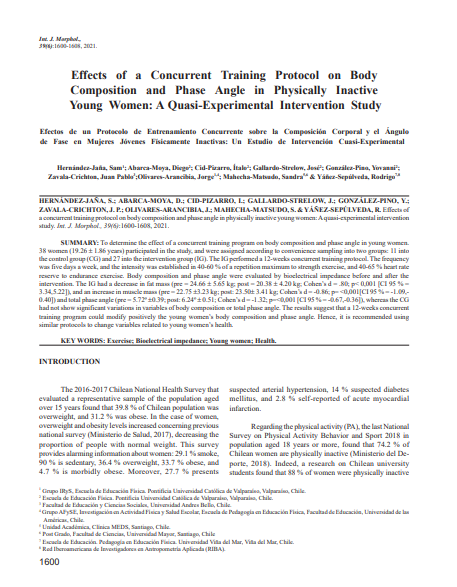Effects of a Concurrent Training Protocol on Body Composition and Phase Angle in Physically Inactive Young Women: A Quasi-Experimental Intervention Study

Fecha
2021-12-29Autor
Hernández-Jaña, Sam
Abarca-Moya, D.
Cid-Pizarro, I.
Gallardo-Strelow, J.
González-Pino, Y.
Zavala-Crichton, J. P.
Olivares-Arancibia, J.
Mahecha-Matsudo, S. [Univ Mayor, Fac Ciencias, Post Grad, Chile]
Yáñez-Sepúlveda, R.
Ubicación geográfica
Notas
HERRAMIENTAS
Acceda a títulos restringidos
¿Cómo descargar?Resumen
To determine the effect of a concurrent training program on body composition and phase angle in young women. 38 women (19.26 +/- 1.86 years) participated in the study, and were assigned according to convenience sampling into two groups: 11 into the control group (CG) and 27 into the intervention group (IG). The IG performed a 12-weeks concurrent training protocol. The frequency was five days a week, and the intensity was established in 40-60 % of a repetition maximum to strength exercise, and 40-65 % heart rate reserve to endurance exercise. Body composition and phase angle were evaluated by bioelectrical impedance before and after the intervention. The IG had a decrease in fat mass (pre = 24.66 +/- 5.65 kg; post = 20.38 +/- 4.20 kg; Cohen's d = .80; p < 0,001 [CI 95 % = 3.34, 5.22]), and an increase in muscle mass (pre = 22.75 +/- 3.23 kg; post: 23.50 +/- 3.41 kg; Cohen's d = -0.86; p=<0,001[CI 95 % = -1.09, -0.40]) and total phase angle (pre = 5.72 degrees +/- 0.39; post: 6.24 degrees +/- 0.51; Cohen's d = -1.32; p=<0,001 [CI 95 % = -0.67,-0.36]), whereas the CG had not show significant variations in variables of body composition or total phase angle. The results suggest that a 12-weeks concurrent training program could modify positively the young women's body composition and phase angle. Hence, it is recommended using similar protocols to change variables related to young women's health.
URI
https://repositorio.umayor.cl/xmlui/handle/sibum/9186https://www.scielo.cl/pdf/ijmorphol/v39n6/0717-9502-ijmorphol-39-06-1600.pdf
http://dx.doi.org/10.4067/S0717-95022021000601600
Coleccion/es a la/s que pertenece:
Si usted es autor(a) de este documento y NO desea que su publicación tenga acceso público en este repositorio, por favor complete el formulario aquí.